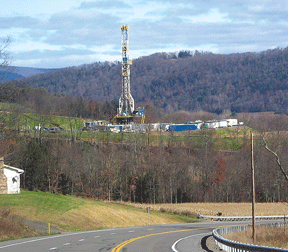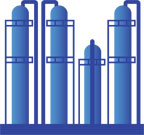Natural Gas, Is it Right for Appalachia?

Tower for drilling horizontally into the Marcellus Shale Formation for natural gas, from Pennsylvania Route 118 in eastern Moreland Township, Lycoming County, Penn. Photo by Ruhrfisch
By Derek Speranza
It’s the middle of July in West Trenton, N.J. More than 600 protesters have gathered outside a meeting of the Delaware River Basin Commission, speaking out to protect the region’s drinking water and water reserves from contamination.
The issue? Natural gas drilling – a controversial practice that has been by some labeled “environmentally safe.” But the citizens of West Trenton are calling to end the process altogether until more environmental research can be done.
Despite the environmental concerns, demand for natural gas as both a transportation fuel and an electricity source has been steadily increasing over the last few decades, which has had small, yet demonstrable economic benefits to Appalachia.
Outside of Asheville, N.C., a greenhouse operation relies on natural gas to heat its facilities in the wintertime. The gas they purchase through PSNC Energy, a large gas provider in North Carolina, is cheaper than oil and burns cleaner than coal.
For these reasons, natural gas is gaining popularity – but its position as a sustainable solution for the future of the Appalachian region remains to be determined.
Some of the Issues
Natural gas is a fossil fuel, and its burning releases new CO2 into the air. That said, it is the single cleanest burning fossil fuel on the market, producing about 45 percent less CO2 than coal, and 30 percent less than petroleum.
While gas burns cleaner than its competitors, the extraction of the gas worries many environmentalists. The most common process of natural gas extraction is hydraulic fracturing, or “fracking” – a technique that involves drilling deeply into the earth, fracturing rock beneath the surface, and injecting a solution of water and chemicals to prop open the fissures in order to remove the gas.
Under current copyright laws, gas companies in many states do not have to disclose the mixture of chemicals they inject during fracking, raising questions about the possible presence of contaminants.
Aside from the injected fluid, large amounts of wastewater are created as a byproduct of hydraulic fracturing, placing unprecedented burden on water treatment plants.
The Marcellus Shale is one of the largest natural gas reserves in the United States. A gigantic gas field located in the heart of the Appalachians (covering large portions of New York, Pennsylvania, Ohio, Virginia and West Virginia), the Marcellus Shale is the source of much debate over the sharp increase of “fracking” permits in the region – and incidentally a sharp increase of wastewater.
The wastewater from hydraulic fracturing contains natural contaminants from the earth – mostly a salty mineral mixture called Total Dissolved Solids (TDS), and sometimes carcinogens such as benzene and cadmium.
According to the Pennsylvania Department of Environmental Protection, water treatment plants in the state are not prepared to handle TDS wastewater in the extreme quantities in which it is being produced – and this is exactly what brought the New Jersey protesters out in droves.
The EPA concluded in a 2004 study that the process of hydraulic fracturing is safe and has no definite effects on drinking water, but criticism of the report prompted the U.S. Congress to request a new study, scheduled for release in 2012.
Benefits and Concerns
Natural gas is the cleanest burning fossil fuel. It also comes relatively cheap.
PSNC Energy, the North Carolina provider, says the price of the natural gas equivalent to one gallon of gasoline is currently about $1.50, significantly less than its petroleum counterpart.
Angela Townshend, public relations official for PSNC, says that while demand for natural gas in Western North Carolina has not increased, it can provide key economic support to businesses in the region.
“Natural gas is often that certain aspect of industry businesses are looking for to meet their energy and manufacturing needs,” said Townshend, citing the Asheville greenhouse among other businesses that rely on PSNC’s gas.
Townshend also says that PSNC offers small incentives for people to switch to more efficient natural gas systems in their homes, offering rebates intended to curb greenhouse gas emissions.
While the use of natural gas in the Appalachian region is not nearly as great as in areas further east, Townshend attributes this to differences in economic development, and says that there is nothing inherently prohibiting Appalachia from further utilizing the resource.
“But PSNC is exclusively a provider,” Townshend reminds. “We don’t do drilling or exploration of any kind.”
The excess load that fracking wastewater places on water treatment plants could potentially burden the taxpayers, who would ultimately be responsible for funding any improvements made to government-run treatment facilities.
Large electric utilities in the Southeast, who have long relied on coal as their primary energy source, are also starting to look toward natural gas. Progress and Duke Energies plan to to retire or convert 24 of their 47 coal-fired generators in North Carolina, with plans to replace a portion of this capacity with natural gas.
As Appalachia moves toward the future, the region must consider the vast energy potential of sources other than coal. Is natural gas the answer? All that is certain is as of now is that the true net economic benefit of natural gas remains a question.
Europe’s New Energy: Natural Gas vs. Wind
In 2009, new wind installations in Europe outpaced new gas installations for the first time ever, with 10 gigawatts of new wind capacity and only 7 gigawatts of new gas capacity.
This reverses a trend reported in 2006, when 20 gigawatts of new gas capacity and 9 gigawatts of new wind capacity were added.
In terms of overall capacity, latest figures still have gas in the lead, with 119 gigawatts of gas energy produced annually, compared to 85 gigawatts of wind energy produced annually.
Related Articles
Latest News

Leave a comment
Your email address will not be published. Required fields are marked *






